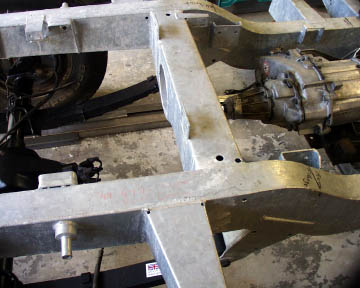The Dana 20 is a center-output case, while the Spicer 18 is an offset case. While some internal parts can be swapped over (to achieve a lower low range in the Dana 20), they are actually different animals.
Here's a little information from our friends at Novak, who know more about these than I ever will (cut n' pasted from:
http://www.novak-adapt.com/knowledge/model_18.htm)
Versions
There are four major styles of the Model 18.
Early Military, 1941-1945
Military versions of the 18 built for the MB & GPW wartime Jeeps have a 1.97:1 ratio low range and a 1:1 high range. These early versions featured a 3/4" diameter intermediate idler shaft and dual shifters. These transfer cases were only married to the Borg Warner T84 three speed transmission and had a 3-5/32" input locating bore.
Early Civilian, 1945-1946
A handful of the earliest civilian Dana 18's that were married to the side-shift version of the T90 feature 2.43:1 low range and have a 3/4" intermediate shaft. Relatively few examples of these exist but the reader should be aware of it. They were developed for the prototype 6x6 Tugs (only 16 of these were made). This transfer case came in the preproduction 1944 CJ-1 and 1944-1945 CJ-2 and were installed in the CJ2A up through serial number CJ2A-24196.
Mid Civilian, 1946-1955
With military restrictions freed up and Willys eyeing the civilian, utility and agricultural markets, the Dana 18 was improved with a lower 2.46:1 low range gear ratio. The intermediate idler shaft was increased to 1-1/8", using caged needle roller bearings. The rear PTO port began to see serious use as a driver of accessories ranging from pumps, winches, generators, farm implements, etc. The locator bore continued to be the 3-5/32" diameter. Casting numbers of C18-15-10 have been seen on these versions.
Later Civilian, 1955-1971
In 1955 (this varies by a year or so on some models; no doubt while Willys-Overland was using up its remaining inventory) Jeeps received the Dana 18 with an 1-1/4" intermediate shaft. This improvement was not indended to increase the shear strength of the pin, but to increase the bearing area and the number of bearings. Free needle rollers, then, replaced the earlier and significantly fewer caged needle rollers. The locator bore continued to be the 3-5/32" diameter.
Final Civilian, 1966-1971
The "large case" version of the Dana 18 was the most improved version of all. It was only found behind the Buick V6 engine with its T86 and T14 transmissions. The case casting used was that from the Dana 18's progenitor, the Dana Spicer Model 20. This case featured a 4" locating bore and a single stick shifter and new front output cap. The front output assembly did not provision for a shifter mounting point, as the shifter was anchored to a transmission bracket. The internals were essentially identical with the standard Dana 18. This version is best thought of as Dana 18 guts in a Dana 20 shell. Individuals can build a "Super 18" by copying this version.
Strength
It is nearly remarkable how much power this compact transfer case can transmit and sustain. It is not so rare to see them handling Big Block grade power and deep, compound gearing.
The 18 is not without a fuse when under extreme service; its offset design causes the reactive driven torque of the driveshafts to apply a large upward moment force against the case and the case can split between the intermediate shaft bore and the PTO port or the case bottom opening. Gears (as with any gearbox) may break under some outstanding circumstances. Also, the forces of the front helical gearset are not captured and balanced by the rear spur gearset, causing these forces to be applied against the case, which may stretch it to a failure point. However, these situations are quite rare and essentially non-issues for the appropriate driver, Jeep and terrain.
The "large case" 18 is the stronger of the lot, though not dramatically so. Its case casting was improved in both engineering terms and in is method of casting.
_________________________________________________________________
The version I have is the "Later Civilian" out of a 1963 Scout 80. While not the "ultimate Spicer 18", it certainly is a good design. It originally sat behind a IH 152 and T-90, which didn't seem to stress it all that much. I replaced all of the bearings and bushings, as well as the intermediate shaft and all sorts of small parts. I figured it was due, after 45 years of service without a rebuild. It turns and shifts smoother than a lot of rebuilt Dana 20s and 300s I've seen, so hopefully that trend will continue when the torque is applied. Nice to dream anyway...

